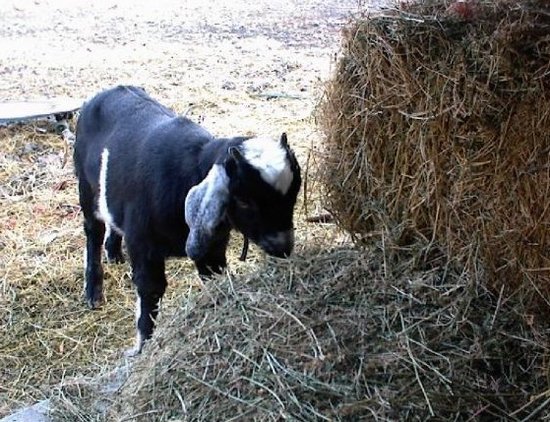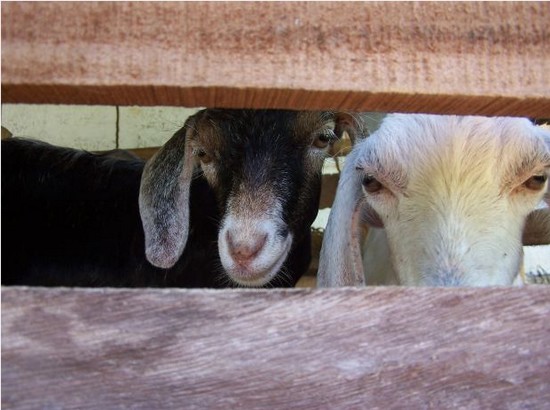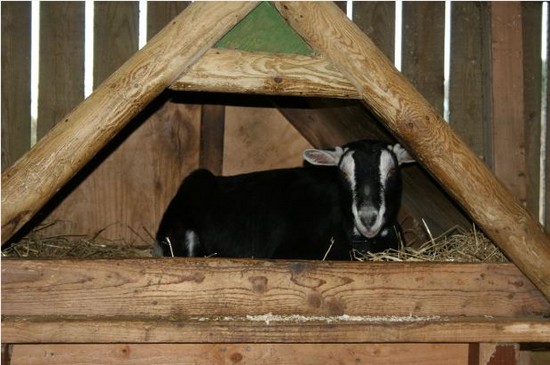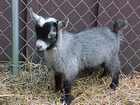Feeding, Housing and Raising Goats for Milking
Raising goats rather
than cows makes more sense for the homesteader because they are easier
to manage, are cheaper to feed, easier to care for, more adaptable to
their surroundings, require less space and are in the main, less work.
Keeping goats is done for a number of reasons, some raise goats for milk, others for meat, some for both, and then there are those that keep them for their fiber. Goats are useful too to clear sections of brambles and briar like no other animal can, and if you are fields are overrun with blackberries and brambles employing goats to do the job is far better than eliminating them with harmful herbicides.
Goats also will not only clear the land of wild blackberries, and the like, but will also eat many weeds and vegetation that are totally unsuitable for sheep.
For those wanting to live a self sufficient existence, keeping goats is not only sensible, but also necessary as they are easily milked and efficient in converting roughage into both milk and meat.
Keeping goats is done for a number of reasons, some raise goats for milk, others for meat, some for both, and then there are those that keep them for their fiber. Goats are useful too to clear sections of brambles and briar like no other animal can, and if you are fields are overrun with blackberries and brambles employing goats to do the job is far better than eliminating them with harmful herbicides.
Goats also will not only clear the land of wild blackberries, and the like, but will also eat many weeds and vegetation that are totally unsuitable for sheep.
For those wanting to live a self sufficient existence, keeping goats is not only sensible, but also necessary as they are easily milked and efficient in converting roughage into both milk and meat.
Raising Goats for Milk

Saanen goats for milking - One of
the best milking goats around.There is no difference in taste
between goat's milk and cow's milk, and in some respects it is in fact
better, as it can be digested by those who would normally have an
allergy to cow's milk, and it is also excellent milk for babies. To me,
the major advantage of keeping milking goats is that they do not
carry tuberculosis bacillus.
Goat's milk is also very good in cheese making because the fat globules are much smaller than cow's milk, don't rise as quickly in the cheese making process and therefore do not get thrown away in the whey at the end.
Making butter with goat's milk, however, is not so successful as it takes a lot longer time as the cream does not rise in the way that it does with cow's milk. However, if you put goat's milk through a separator first, you have then be able to make excellent butter without too much of a sweat.
Goat's milk is also very good in cheese making because the fat globules are much smaller than cow's milk, don't rise as quickly in the cheese making process and therefore do not get thrown away in the whey at the end.
Making butter with goat's milk, however, is not so successful as it takes a lot longer time as the cream does not rise in the way that it does with cow's milk. However, if you put goat's milk through a separator first, you have then be able to make excellent butter without too much of a sweat.
Raising the Best Milking Goats
When raising goats for
milking, your best milking goats will produce a
large volume of milk despite
their size. You can except up to 8 liters in summer and around 1.5
liters in the winter. On average 3-4 liters a day can be expected.
British Saanen goats have an excellent reputation of being good milking goats. Originally a large Swiss breed that is a high yielder, but has to be given good pasture in order for it to produce well. Despite their size they are docile animals and easy to handle.
The Toggenburg is another Swiss breed, smaller than the Saanen, and not so fussy with what it eats in that it will yield well if just fed grass. Also good to handle.
The Anglo-Nubian goat is not a heavy yielder of milk, but what it lacks in volume it makes up in the quality of milk it gives as the milk is very rich. Easily recognized by its lop-ears, it is a good duel-purpose goat as it is also good for eating.
The British Alpine goat is a big black and white goat which is a good milker and also good for grazing.
If you are really tight on space you may look at a miniature breed of goat such as the Nigerian dwarf goat. Raising goats on a small piece of land is possible, and the volume of milk is not that different to goats of a normal size.
British Saanen goats have an excellent reputation of being good milking goats. Originally a large Swiss breed that is a high yielder, but has to be given good pasture in order for it to produce well. Despite their size they are docile animals and easy to handle.
The Toggenburg is another Swiss breed, smaller than the Saanen, and not so fussy with what it eats in that it will yield well if just fed grass. Also good to handle.
The Anglo-Nubian goat is not a heavy yielder of milk, but what it lacks in volume it makes up in the quality of milk it gives as the milk is very rich. Easily recognized by its lop-ears, it is a good duel-purpose goat as it is also good for eating.
The British Alpine goat is a big black and white goat which is a good milker and also good for grazing.
If you are really tight on space you may look at a miniature breed of goat such as the Nigerian dwarf goat. Raising goats on a small piece of land is possible, and the volume of milk is not that different to goats of a normal size.
Raising Goats and Feeding

Some may have a pre-conceived idea after watching cartoons of goats eating the washing off the line, that they will eat anything. Well, they will in a way, but if you are raising goats properly, you will also need to make sure that they have a balanced diet.
If you are keeping milking goats and you don't give them a good diet what you will end up with is that nasty smelling milk that no one will want to drink. Believe it or not, goats are actually very fussy eaters who will never eat anything off the floor of their shed!
Remember too, that in the wild, goats are browsers, not grazers and therefore like to eat their food in managers that are elevated. They need to graze outside during the day, as well as receive 2 meals a day, once in the morning and once in the evening.
They like eating crushed oats, broad bran, peas, beans, molasses, flaked maize, barley, linseed cakes and salt. All of this should be mixed up with some greens from the veggie patch, along with any fallen apples and even oranges, and root vegetables. In the winter a doe in milk should be given just short of a kilo of good hay in addition to the above.
On average, in addition to the kilo of hay, a goat in milk should be getting half to a kilo of root vegetables, greens or fruit daily and about the same again in grain.
Many of the vegetables and feed you can grow if you are homesteading, even on a small basis. Grow sunflowers for your goats. Sunflower seeds are excellent for milk production and they will eat the whole plant. Also grow Jerusalem artichokes, mangel beets, kale, turnips, comfrey, carrots and pumpkins. All will be well appreciated. They also like sweetcorn husks and stalks, and is good roughage for them.
If you have a field full of nettle or dandelions these are rich in Vitamins A and C and necessary to a good diet and loved by goats. Feeding them nettle will also increase their milk productivity. Lambsquarters and ragweed are also well appreciated.
How much you give really depends on how big your goats are, their age and what else they are given during the day. However, a dry doe will not require as much feeding as a milking doe, and if you feed your goats too much grain they can end up bloated. Bloat is a serious illness in goats that can lead to death.
To prevent overfeeding of grain, only give in small amounts after they have fed on plenty of grass or well-cured lucerne hay. If you can, place each goat in a separate feeding stall with its own feed making sure that it only eats what is alloted to it.
A goat's digestive system can also be upset if changes to the diet are made too rapidly. So make slow changes and make sure that you feed your goat at the same time each day.
Clean drinking water should be available at all times and the container should be scrubbed out regularly to get rid of any algae that might have formed as goats again are fussy, and will refuse to drink from a slimy trough.
Finally, when raising goats, if you have put your goats out to pasture make sure that the grass that you are feeding them is not too lush as they will end up with bloat if allowed to eat such grass for more than an hour a day. It is just too rich for their systems and they will get sick as a result. Ideally the goat should have access to leaves, branches and tough grasses to make up the essential vitamins and minerals important in its diet.
Raising Goats and Cutting Feed Costs
In order to cut down on
your feeding costs you could grow your own hay
and any grass clippings can easily be made into silage by stuffing the
cuttings into fertilizer bags as tightly as possible. Weigh
them down with old tires or the like and and leave them until they have
started to ferment. Then use for feeding your goats.
Raising Goats and Keeping them Behind the Fence

Choosing the right fencing for goats is very important.
Never think that you
have outwitted your goats because you have found
out how they are escaping, because as soon as you have solved the
problem they are scheming away as to how to find another escape route.
Goats are very smart, and very determined!
There are only 2 ways to outsmart your goats and keeping them fenced in; one is to use electrical fencing, and the other is to replace any diamond-mesh fencing with chain-link fencing.
Three strands of electric fence, with three wires at 15 inches (38cm), 27 inches (69cm) and 40 inches (102cm) above ground level, will restrain goats, and so will a 4-foot (1.2m) high fence of chain link with a support wire at 4-foot 6 inches (1.4m) and another support wire lower down.
Remember when raising goats that they love to climb and so if your goats have access to a rocky outcrop they will be delighted. Having large rocks for you goats is also a way in which you can keep their hoofs trimmed naturally.
There are only 2 ways to outsmart your goats and keeping them fenced in; one is to use electrical fencing, and the other is to replace any diamond-mesh fencing with chain-link fencing.
Three strands of electric fence, with three wires at 15 inches (38cm), 27 inches (69cm) and 40 inches (102cm) above ground level, will restrain goats, and so will a 4-foot (1.2m) high fence of chain link with a support wire at 4-foot 6 inches (1.4m) and another support wire lower down.
Remember when raising goats that they love to climb and so if your goats have access to a rocky outcrop they will be delighted. Having large rocks for you goats is also a way in which you can keep their hoofs trimmed naturally.
Raising Goats and Tethering
Some people like to
tether their goats, and where it may work in the
short-term, in the long-term it is not a good idea. First of all it has
been known for some goats to end up strangling themselves. If you live
in an area where there
are snakes or other predators, you goat has nowhere to go. Finally, if
you leave your goat in one place it will be susceptible to internal
parasites.
If you are hell-bent on tethering, harness with a wide collar, then give them a running tether where you can then change the strip on a regular basis and move the goats further along the field. Also make sure that the goat has access to shade during the day, as well as water and a salt lick.
If you are hell-bent on tethering, harness with a wide collar, then give them a running tether where you can then change the strip on a regular basis and move the goats further along the field. Also make sure that the goat has access to shade during the day, as well as water and a salt lick.
Housing and Raising Goats

Housing Goats
Goats are not as hardy
as cows, especially during winter, and like a
dry, draught-free shed but with good ventilation. Any windows should be
placed high up to allow fresh air, but still draught-free.
Goats also hate rain so therefore a shed is a must.
The floor should be made of concrete so that it can be easily scrubbed and cleaned when necessary and ideally it should have a bit of a slope to it for drainage. To keep the goats off the cold floor, as well as to soak up urine and the like, have a good depth of straw covering the concrete. Foot-rot is common in goats who are kept in poorly drained, wet conditions.
Keep adding clean straw to the floor until the floor has increased in height to about a foot to a foot and a half. Then remove the straw, and add it to your compost heap.
The size of your shed will depend on the number of goats you intend to keep as well as their size, however, the shed should be big enough to allow the goat to stand up, turn around and lie down. For 3 grown goats a shed space of 10 x 15 feet is large enough. In the shed should be a manger that is hanging off the wall, filled with well-cured lucerne hay, so that the goats can feed if its hungry and it will also give it energy to keep warm.
The floor should be made of concrete so that it can be easily scrubbed and cleaned when necessary and ideally it should have a bit of a slope to it for drainage. To keep the goats off the cold floor, as well as to soak up urine and the like, have a good depth of straw covering the concrete. Foot-rot is common in goats who are kept in poorly drained, wet conditions.
Keep adding clean straw to the floor until the floor has increased in height to about a foot to a foot and a half. Then remove the straw, and add it to your compost heap.
The size of your shed will depend on the number of goats you intend to keep as well as their size, however, the shed should be big enough to allow the goat to stand up, turn around and lie down. For 3 grown goats a shed space of 10 x 15 feet is large enough. In the shed should be a manger that is hanging off the wall, filled with well-cured lucerne hay, so that the goats can feed if its hungry and it will also give it energy to keep warm.
Raising Goats for Milking and Mating your Doe
Although
does can be mated as early as 6 months, it is really better to wait
until she is 18 months old. After that she will need to be kept in foal
every year if she is to be kept as a milking doe to give you a regular
supply of milk.
The breeding season for goats begins in the autumn and goes through to early spring during that time your doe will bleat a lot, twitch her tail and be generally restless until she is covered. During the mating season the doe will come into heat every 21 days for 2 days until she falls pregnant.
The gestation period for goats is 5 months and signs that the kid or kids, if you are lucky and not uncommon, are about to appear will be her enlarged udders, bleating, going off her food, and a white vaginal discharge that shows that the birth will be soon.
The breeding season for goats begins in the autumn and goes through to early spring during that time your doe will bleat a lot, twitch her tail and be generally restless until she is covered. During the mating season the doe will come into heat every 21 days for 2 days until she falls pregnant.
The gestation period for goats is 5 months and signs that the kid or kids, if you are lucky and not uncommon, are about to appear will be her enlarged udders, bleating, going off her food, and a white vaginal discharge that shows that the birth will be soon.
Raising Goats and Kids
Leave the kids with the mother for 2-3 days so that they get all the anti-bodies they need to be healthy adult goats received from the colostrum in the early milk. After that, separate the kids from the doe and feed them with a bottle.Newly
born kids should get 500 ml three times daily for the first 2 weeks and
make oaten hay or very dry hay available all the time. Thereafter,
reduce the milk gradually and increase the hay intake and a little
grain until the kids are weaned.
You can milk the doe for 6 months before breeding her again. You could milk her for 3 months more, but then after that allow her to dry off before she has her new kid as if you don't you will exhaust her strength and she will lose condition over time.
You can milk the doe for 6 months before breeding her again. You could milk her for 3 months more, but then after that allow her to dry off before she has her new kid as if you don't you will exhaust her strength and she will lose condition over time.
Add your Own Comments on Raising Goats here!
Do you have anything to add on raising goats here? Or perhaps you have some tips you can give to others on raising goats? We would love to hear from you!
Leave a Comment
Do you have anything that you would like to add after reading this page? We would love to hear your thoughts. If you can add additional information to what has been written here you will be adding value to the website! No need to have any special skills - just type and submit. We will do the rest!
Other Comments
Click below to see comments from other visitors to this page...
Grass silage Not rated yet
I have been interested in the item you have in the article about silage. I didn't know that it could be done on a small scale.
Could regular plastic …
Follow Us: Facebook, Twitter, Google+, Pinterest, RSS
 |
 |
 |










New! Comments
Do you have something of value to add? Leave me a comment in the box below.